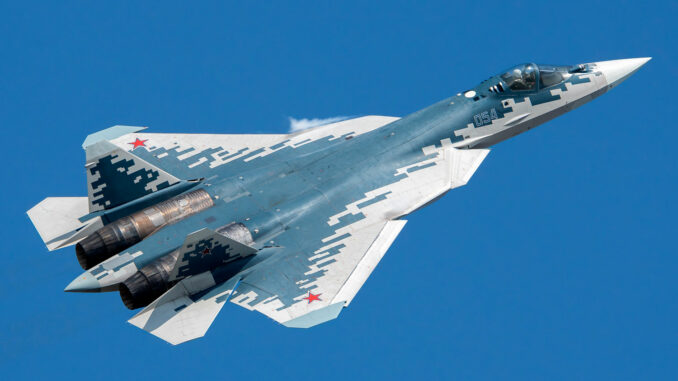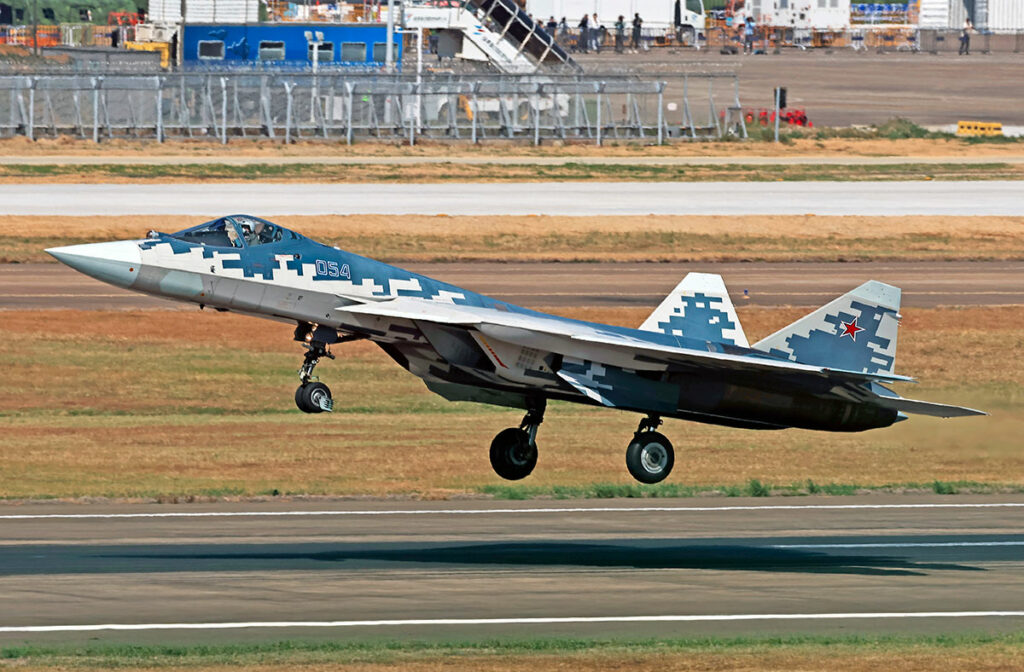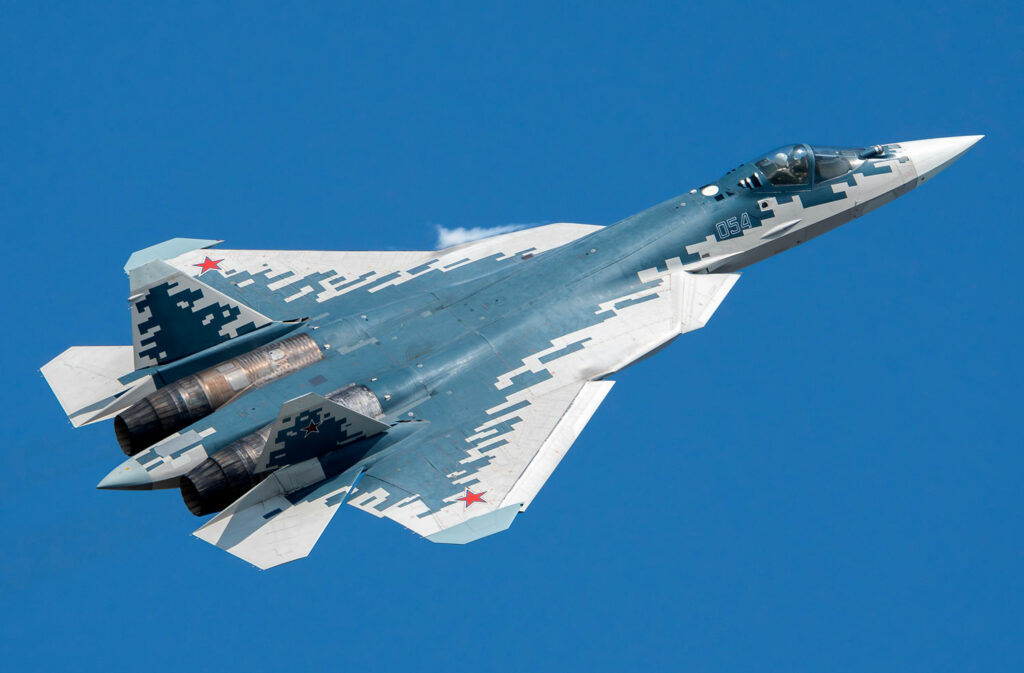
The Sukhoi-57 pushes the limits of maneuverability with its lift-nose, movable canards, and asymmetric thrust vectoring, revealing a major advantage of Russian aviation.
The Sukhoi-57 and the super-maneuverability revolution
The Sukhoi-57 fighter jet marks a break with the design of 5th generation Russian fighters. Designed by Sukhoi based on the PAK FA program, it combines stealth, supersonic cruise speed, and the super-maneuverability of the Sukhoi-57. This last feature is based on three main devices: the Sukhoi-57’s levcon technology, the Sukhoi-57’s movable canards and the Sukhoi-57’s asymmetric thrust vectoring. Together, they provide unprecedented aerodynamic flow control, particularly in post-stall conditions, an area where few Western aircraft can compete.

Control of the aerodynamic center by the levcons
The levcons (Leading Edge Vortex Controllers) are movable surfaces located at the root of the wings, directly in front of the air intakes. Unlike simple fixed extensions (LERX), they are electrically controlled and can be deployed or retracted depending on the angle of attack and speed.
- Main function: to modify the position of the aerodynamic center of the Sukhoi-57 by generating stable vortices at very high angles of attack (up to 60°).
- Effect on stability: the aircraft can maintain precise control even when the main wing is partially stalled.
- Advantage in terms of stealth: unlike the conventional canards seen on the Su-30 or Su-35, the levcons, which are integrated into the fuselage, offer a compromise between control and reduction of the radar cross section.
These surfaces also help manage airflow to the engine inlets, optimizing thrust at high angles of attack.
The role of movable canards in extreme maneuvers
The movable canards on the Sukhoi-57, located near the wings, are not simply secondary control surfaces. They work in coordination with the levcons and horizontal stabilizers.
- Post-stall control: during post-stall turn control of the Sukhoi-57, the canards maintain lift at the front of the fuselage and prevent total loss of control.
- Vortex management: they reinforce the flow generated by the lift control surfaces, stabilizing the nose of the aircraft at extreme angles of attack.
- Resilience: even in the event of thrust vector failure, the aircraft remains controllable thanks to the combination of lift control surfaces, canards, and stabilizers.
These features explain why the Su-57 can perform a flat spin with the Sukhoi-57 while maintaining a controlled trajectory and recovering more quickly than older fighter jets.
Asymmetric thrust vectoring: a Russian innovation
Propulsion is provided by two Saturn AL-41F1 turbojet engines equipped with 3D thrust vectoring nozzles. Unlike the F-22 Raptor, whose thrust vectoring is limited to the vertical axis, the Su-57 uses asymmetrically steerable nozzles.
- Deflection amplitude: up to ±16° in all axes, allowing pitch, yaw and roll torques to be created.
- Asymmetrical mode: one nozzle can deflect differently from the other, creating a roll moment even without action on the control surfaces.
- FADEC + flight controls coupling: full integration allows the KSU-50 flight system to simultaneously manage the engines and aerodynamic surfaces, ensuring optimal coordination between thrust and aerodynamic control.
This configuration gives the Su-57 immediate response to commands, even at near zero speed, which is essential for so-called “super-agility” maneuvers.
Iconic maneuvers: Cobra and flat spin
The Cobra maneuver with the Sukhoi-57
This iconic Russian maneuver involves abruptly raising the nose to an angle greater than 100° of incidence before returning to a normal attitude.
- With the Su-57, the Cobra is achieved through the synergy of levcons + canards + thrust vectoring.
- The tactical advantage lies in the ability to break horizontal speed and disorient a pursuer in close combat.
The flat spin maneuver with the Sukhoi-57
The flat spin is a flat spin, often fatal on conventional aircraft.
- On the Su-57, the combination of mobile controls and asymmetric thrust allows the aircraft to enter a spin deliberately and then exit it with precise control.
- This opens up new tactical possibilities: surprising an opponent by presenting an unstable but quickly recoverable target.

Aerodynamic performance figures
- Maximum speed: Mach 2.0 (2,120 km/h).
- Supercruise: Mach 1.3 without afterburner.
- Range: approximately 1,800 km in air superiority missions.
- Wing loading: approximately 470 kg/m², ensuring a compromise between maneuverability and endurance.
- Future engine (Izdeliye 30): planned to increase thrust to 18,000 kgf, with reduced infrared signature.
These figures illustrate that the aerodynamic performance of the Sukhoi-57 is not based solely on raw thrust, but on a subtle balance between moving surfaces, thrust vectoring, and unstable aerodynamics.
The Sukhoi-57’s advanced flight control system
The Sukhoi-57’s advanced flight control system is assisted by a redundant fly-by-wire system.
- Pressure and angle of attack sensors provide real-time flow parameters.
- The KSU-50 computer adjusts the position of the lift control surfaces, canards, and nozzle deflection in milliseconds.
- The goal is to maintain artificial stability in conditions where the aircraft is naturally unstable.
This architecture enables the aircraft to perform maneuvers that are impossible for a conventionally piloted fighter.
A comparison with Western stealth aircraft
In terms of pure stealth, the Su-57 lags slightly behind the F-35 and F-22, as the presence of moving surfaces increases the radar signature.
However, in terms of the extreme maneuverability of the Sukhoi-57, no Western fighter in production offers such a combination of:
- adjustable lift-nose wheels,
- integrated canards,
- and asymmetric thrust vectoring.
The Russian approach differs: instead of focusing on absolute stealth, it emphasizes aerodynamic versatility. Thus, in close combat, the Su-57 can perform maneuvers outside the conventional flight envelope, offering a tactical advantage over less maneuverable Western stealth aircraft.
A vision of the future
The Sukhoi-57 fighter jet illustrates the Russian philosophy: maintain the advantage in close air combat while integrating modern stealth and networked warfare standards. The future arrival of the “Izdeliye 30” engine will further reinforce this logic, increasing specific thrust and reducing the thermal signature.
Beyond the figures and air demonstrations, the Su-57 symbolizes a trend: while the West favors stealth and BVR (Beyond Visual Range) weaponry, Russia continues to perfect the tools of dogfighting. This technological divergence suggests that tomorrow’s air battles will not be limited to electronics, but will continue to rely heavily on aerodynamic mastery and extreme maneuverability.
War Wings Daily is an independant magazine.